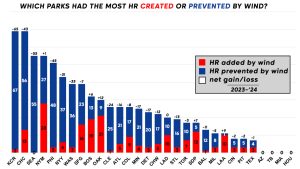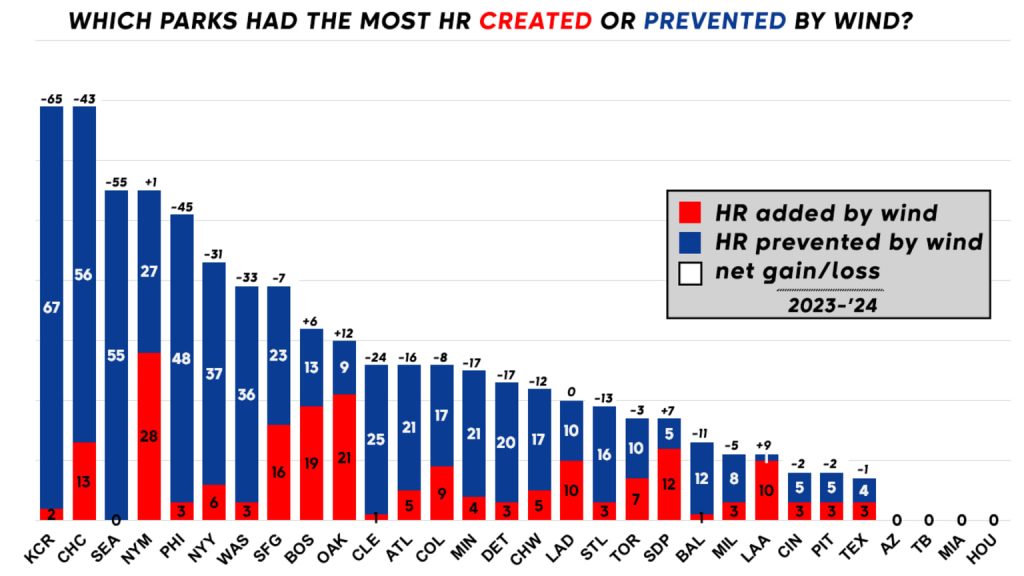
Overview
The All-Star break arrives on Monday for big-league baseball which always features a Home Run Derby that’ll take place on Monday evening in Atlanta, Georgia and the All-Star game will be played on Tuesday night. The weather looks quite hot and humid both for the Home Run Derby and the All-Star game and – as has been typical lately – there are likely to be isolated-to-scattered showers and thunderstorms in the area. The high heat and humidity expected in Atlanta for the Derby should be quite favorable for baseballs to carry so there are likely to be some mammoth shots in Truist Park. Winds will not be much of a factor during either night, but a recent detailed analysis confirms the notion that winds can be highly influential in the distance a ball can travel…and there were some surprising findings as well.
Details
Studies have shown that weather conditions can affect the distance a baseball can travel by more than 20% depending on the temperature, humidity and atmospheric pressure and all of these factors and more are considered in the calculation of the Home Run Forecast Index. The less dense the air, the greater distance a baseball can carry, and high heat and humidity in Atlanta on Monday should be quite favorable for some mammoth shots during the annual Home Run Derby (a high Home Run Forecast Index is expected). Temperatures will soar to well up into the 90’s on Monday and they’ll be slow to drop during the evening hours and overall humidity levels will remain uncomfortably high. Another factor that influences the density of the air and the ability of a ball to travel is the altitude of a given stadium and Atlanta’s Truist Park which opened in April 2017 is the 3rd highest in all big-league baseball. Truist Park sits at around 1000 feet just behind Arizona’s Chase Field (1086 feet) and far behind the highest…Coors Field in Denver (5190 feet). The rather high altitude in Atlanta is yet another favorable factor for the possibility of seeing some tape-measure type home runs during Monday’s Home Run Derby.
Winds are another important weather-related factor that can strongly influence the distance a baseball can travel. Winds can be quite supportive of the hitting of home runs (blowing out) or they can be quite detrimental (blowing in). Wrigley Field in Chicago is well known for those very high scoring games featuring numerous HRs when winds are blowing out on a hot summer day (or night). However, a somewhat surprising finding came recently in detailed wind analysis by Major League Baseball during all games of the 2023 and 2024 seasons. As it turned out, winds are far more often to be detrimental when it comes to hitting home runs at Wrigley Field as well as some other stadiums including Kaufmann Stadium in Kansas City, T-Mobile Park in Seattle, and Citizens Bank Park in Philadelphia. Specifically, there 56 balls prevented by the wind from being HR’s at Wrigley Field in Chicago with only 13 HR’s created. The results were even more dramatic in Kansas City where 67 balls were prevented from being HR’s by the wind and only 2 were created. In Philly and Seattle, big discrepancies took place as well during this two-year period with the ratio of prevented and created 48 to 3 in Philly and 55 to 0 in Seattle.
The key to this finding that the wind can actually be more detrimental to the hitting of home runs rather than supportive has to do with the typical orientation of the field and the basic structure of the stadium. Most big-league parks are oriented from S/SW to N/NE with home plate on the S/SW side and center field on the N/NE side. This has been tradition from way back in the early seasons of baseball in order to have the sun behind the batter and not a hinderance to their vision. Given this typical orientation, low-level winds blowing out from a S/SW direction are disrupted or impeded by the fully enclosed and high height rows of seats from the 1st base side to the 3rd base side. In the outfield, however, low-level winds blowing in are far less disrupted or impeded by any structures with only scoreboards a hinderance in some stadiums such as Wrigley Field in Chicago or Citizens Bank Park in South Philly.
One final note, of the 8 participating players in tonight’s Home Run Derby, the longest HR hit during the 2025 season was 479 feet by Byron Buxton of the Minnesota Twins on June 11th versus the Texas Rangers…quite likely to see something greater than that tonight in Atlanta.
Meteorologist Paul Dorian

